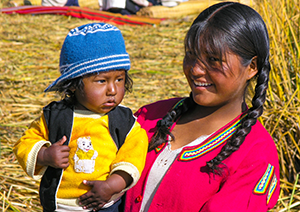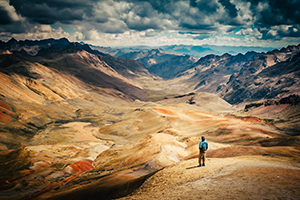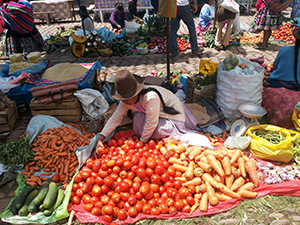Travel Like a Native: Peru

Peru: from the Mountains to the Sea
Located in western South America, Peru has a deep cultural history. It's known for one of the oldest civilizations, the Norte Chico, who have settlements dating back to as early as 3200 BC.
Other fascinating and impressive achievements in Peru's ancient history include the city of Nazca, famous for their earthen lines which can only be truly appreciated from an aerial view, and the Inca Empire, who created one of Peru's most notable sites: Machu Picchu.
< Today, Peru's multiethnic population is comprised of individuals of indigenous, European, African and Asian descent, which results in a diverse and vibrant cultural experience for travelers. It also offers some of the world's most gorgeous natural habitats -- from jungles to mountains to beaches -- so you can cover it all during one visit to this breathtaking country.
Today, Peru's multiethnic population is comprised of individuals of indigenous, European, African and Asian descent, which results in a diverse and vibrant cultural experience for travelers. It also offers some of the world's most gorgeous natural habitats -- from jungles to mountains to beaches -- so you can cover it all during one visit to this breathtaking country.
To learn more about Peru, we asked instructor Teresa Ramon Joffre to share her perspective on her native country; read on to learn more about cultural similarities and difference, tips and recommendations, and more.
What is the primary language spoken in Peru, and how important is it that a traveler be familiar with it before they visit?
The primary language of Peru is Spanish. I think it is very important to speak at least some words to get by.
Of course, Peru is a very popular destination so people in the tourism industry speak very good English. However, it is great if you can learn some Spanish in advance to get by and make the experience more enjoyable.
What are some of the differences in communication style between Peru and the US?
These are just my perceptions, of course, but here are some differences in how Peruvians interact with each other:
- Personal space - I think in the US the personal space bubble is bigger.
- Greetings - In Peru, most people greet with one kiss on the cheek. Of course, that is gradually changing, especially in a business environment.
- Informality - Some public transportation in Peru is pretty informal, or, to say it nicely, too laid back. Local buses are a whole new experience for tourists!
- Punctuality - Some people arrive a bit late; it used to be that most people did, so this is gradually changing.
 What are some similarities between Peruvian and US cultures?
What are some similarities between Peruvian and US cultures?
- Friendliness - I think people in both cultures are pretty friendly and kind. Sincere smiles open doors.
- Eating - We like to eat. We like to go to parties and have friends. Many people like coffee.
Ultimately, I believe that we are all the same. Some are luckier than others, some have had a better environment, better living conditions than others. But we all want the same things: to be happy, healthy, and safe.
What should a traveler keep in mind when they're interacting with Peruvians?
- Be friendly and smile.
- It's good to be trusting, but cautious.
- Be generous and respectful.
- Dress in simple clothes.
- No big cameras or expensive jewelry/glasses. In other words, no frills.
Just remember the golden rule of travel: When in Rome ... (of course, only when it is about doing good things!).
by Kat Oak, June 2018 with minor updates by Liza Burke, June 2021